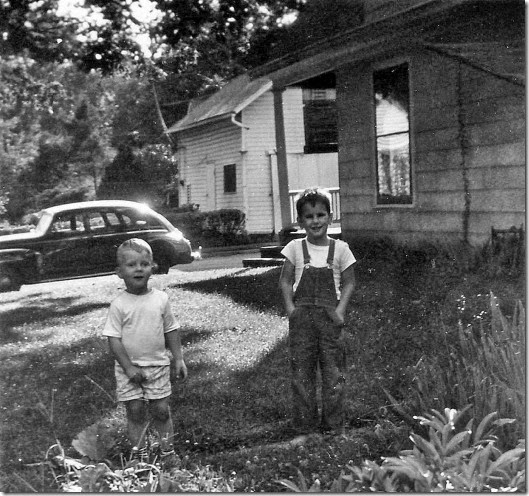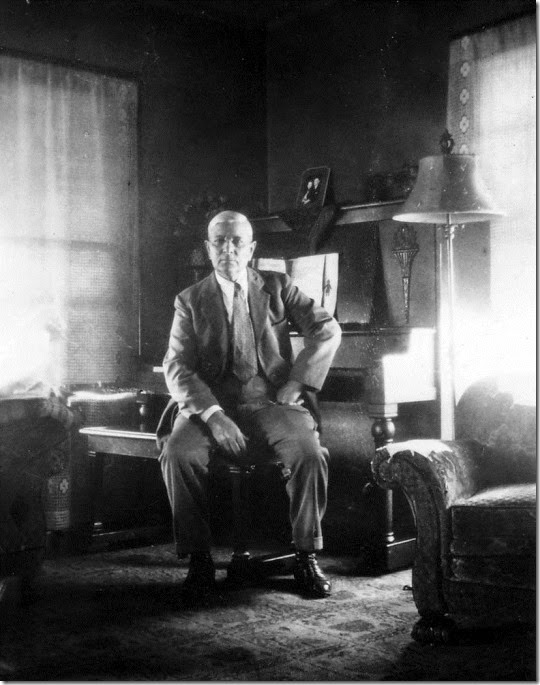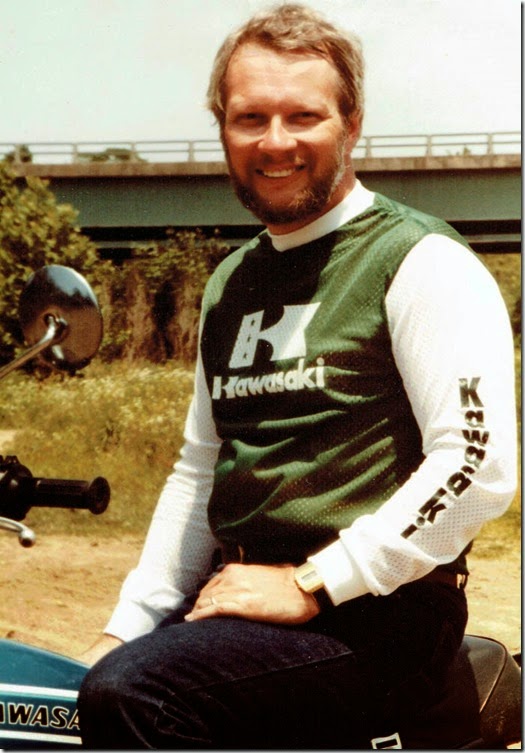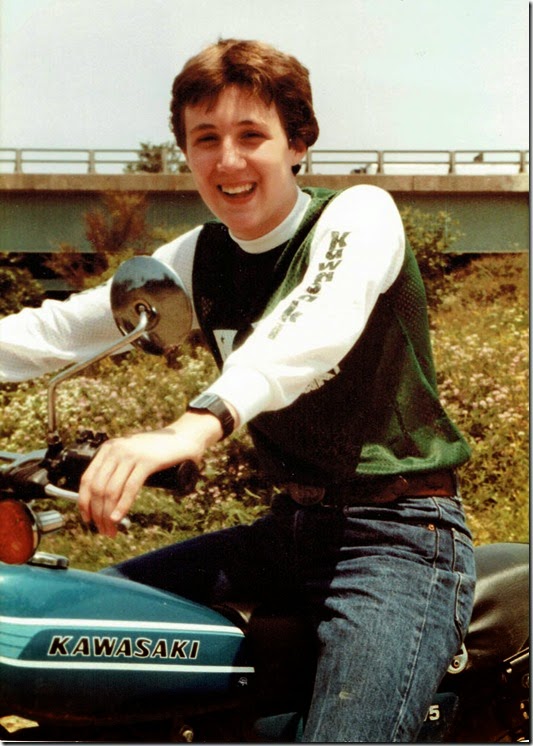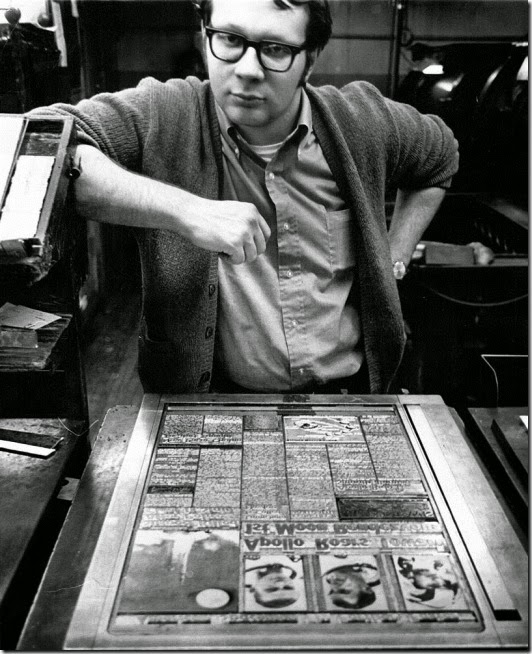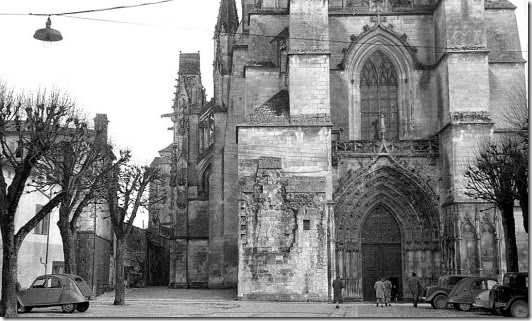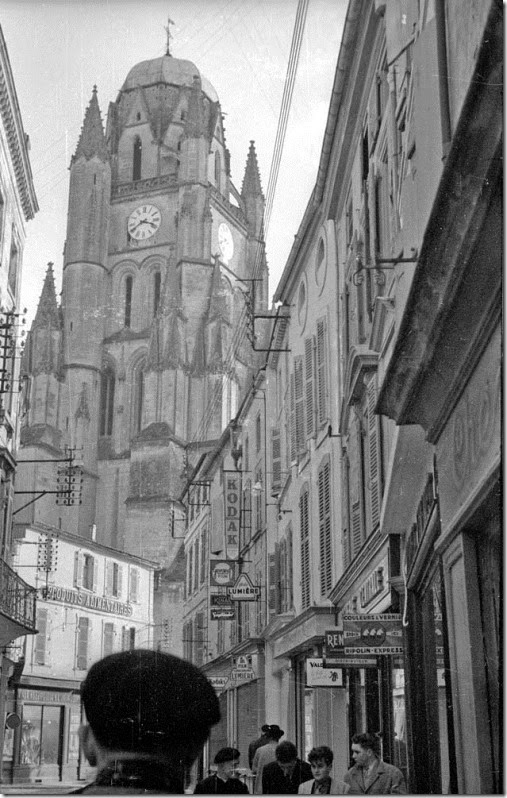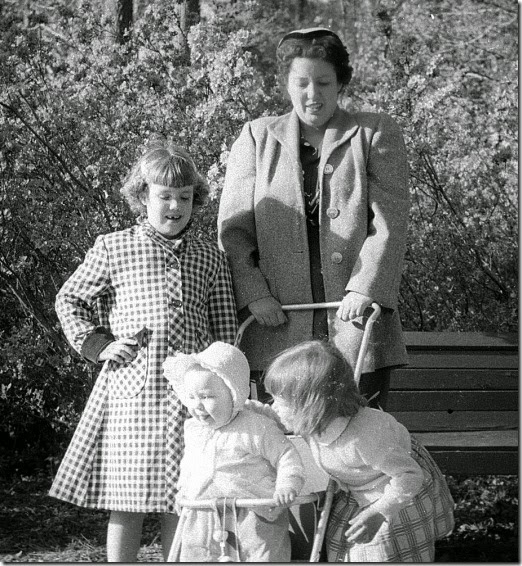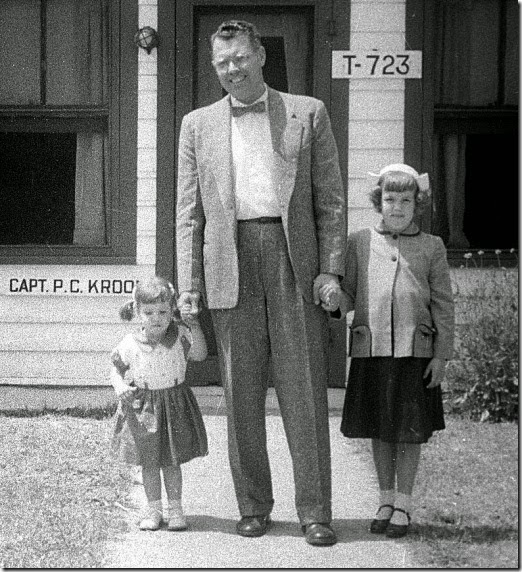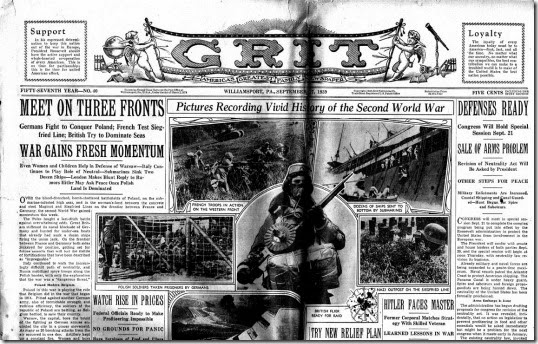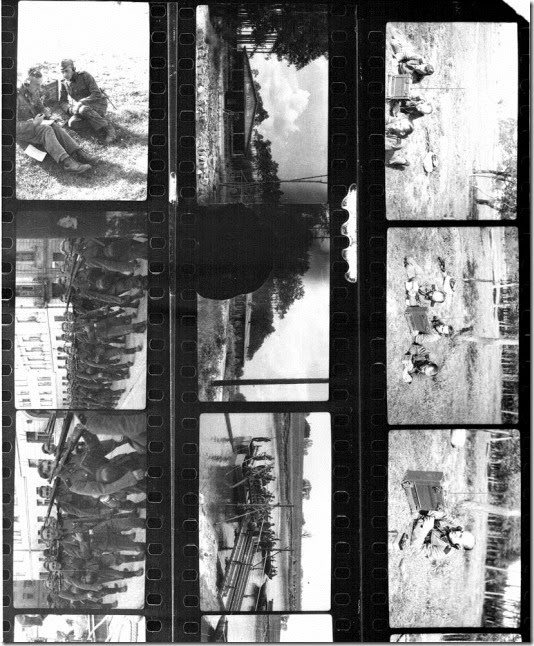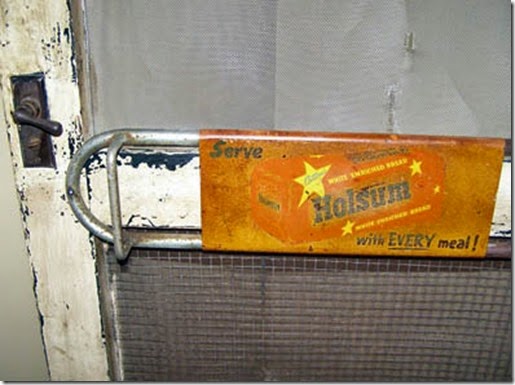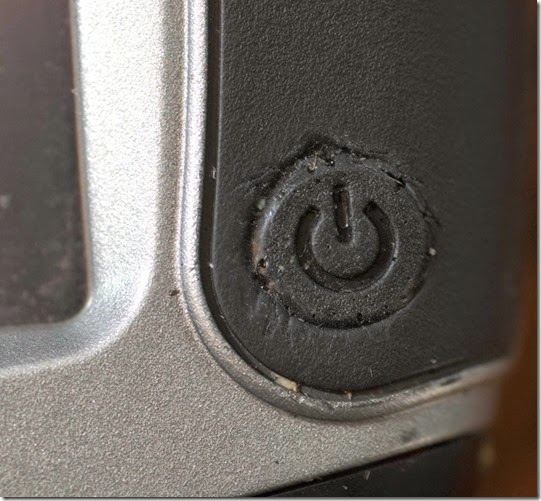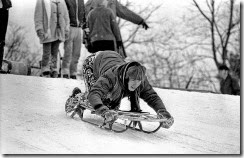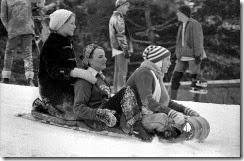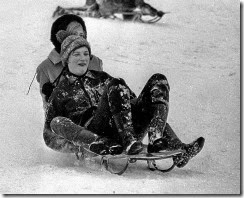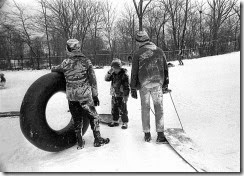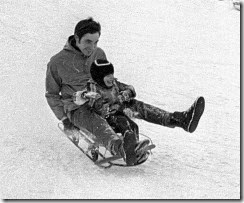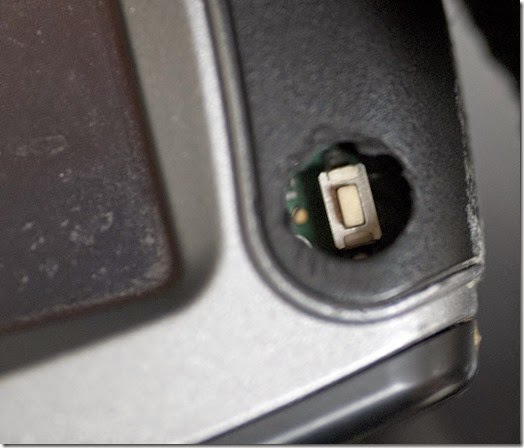The dark mutterings of a former mild-mannered reporter for a large metropolitan daily newspaper, now living in obscurity in central Indiana.
Saturday, January 31, 2015
Friday, January 30, 2015
He got his mother’s eyes
Pete, our first Aussie who died shortly after his seventh birthday, had beautiful, expressive brown eyes that helped make his innate sweetness all the more endearing.
I was reviewing images stored on a solid state hard drive and found the photos we shot the day we visited the farm east of Crawfordsville where Pete and his littermates awaited adoption in November, 2005.
Pete’s dad was a miniature Aussie and his mom was a full-size Aussie. We had a few photos of his mother and it immediately became obvious where he got his soulful eyes.
Here’s Pete’s mom:
Me and Jeff
The caches of old photos keep turning up and continue to yield surprising images and memories.
Like this one of me and my pal Jeff Clayton around 1949 or 1950.
Jeff’s father, Bernard Clayton, grew up in Zionsville where his father owned The Zionsville Times. Bernard was a newspaper guy too and worked at The Indianapolis News and ran bureaus in Chicago and San Francisco Time and Life magazines. He was a military correspondent in World War II and was lucky enough to be on the USS Missouri when the Japanese signed the surrender documents in Tokyo Bay in August, 1945, and witnessed the proceedings. After the war, he settled in San Mateo, Calif. and handled public relations for Matson steamship lines, which did a booming post-war business carrying passengers to and from Hawaii.
I’m a little fuzzy on when he married Marjorie Roach, but it had to be before or during WWII. Marjorie was a daughter of Harry and Minnie Roach of Delphi, Ind., and Jeff spent a few weeks some summers at their house, which is how I came to know him. That’s the Roach house and yard in the photo. Their yard and ours were separated by a long line of peony bushes.
The last time I saw Jeff was sometime in the 1980s when he traveled from California to spend Christmas with his parents who, by that time, were living in Bloomington, Ind.
Dropping out of the corporate world in 1964, Bernard and Marjorie traveled the U.S. and Europe for a couple of years before he was recruited by Indiana University for a special project. In the course of their travels, Bernard took up cooking and wrote cookbooks, the most successful of which were “Bernard Clayton’s Complete Book of Small Breads” (1998) and “The Complete Book of Soups and Stews,” first published in 1984 and reissued in a revised edition in 2006. Bernard died in Bloomington in 2011 at the age of 94.
He is one of a handful of my acquaintances to rate an obituary in The New York Times.
I’ve lost track of Jeff. There are a lot of Jeffrey Claytons in the U.S., but I suspect he’s the one who lives in Twin Peaks, Calif.
Thursday, January 29, 2015
I fell, but I got right up
I misjudged the curb at the post office where it tapers down to a wheelchair ramp Tuesday morning and found myself on the pavement.
It startled the hell out of a young guy just opening the door to the building.
I remember saying, “Shit!” as I landed on my right side, abrading two knuckles and getting a couple of abrasions on my right leg and knee.
Fortunately, I was wearing my German Polizei leather jacket, which spared me more abrasions on my arm and shoulder.
“Thank God for leather,” I said, embarrassedly as I scrambled to my feet and regained my composure, quietly cursing my inattention.
Thinking about it later, it occurred to me that the CDC and other medical authorities have made a big deal about falls and senior citizens.
I still have trouble thinking of myself as a senior citizen, even though I’ll be 70 in July, so I figured those warnings didn’t apply to me.
Then I recalled it was a slip and fall on ice that put my dad in a downward spiral. As a consequence of the dreaded broken hip, he spent most of his remaining years in a nursing home.
Granted, he was in his 80s when he fell, but the point is worth noting.
I guess I have a couple of choices – either wear my motorcycle gear all the time or get my head out of my ass and pay attention to where I put my feet.
Wednesday, January 28, 2015
Tesla P85D Insane Mode Launch Reactions Compilation - Explicit Version
My son Steve and his wife Nicky bought a Tesla late last year.
The original Flora Music Man
I’ve been clearing out boxes from our garage that have been there since we move here from Indiana more than seven years ago and finding several old family photos that are worth preserving.
Yesterday’s scans included this wonderful image of my grandfather, Irvin Monroe Flora on a piano bench in the parlor of the farm house where he and his wife, Bertha LaDora Long Flora, raised nine children.
The Flora family farmed 80 acres in southern Carroll County, Indiana. Irvin Flora served as Trustee of Democrat Township and later as Carroll County Treasurer. During the 1920s, my Dad tells me, Irvin had the distinction of being the only farmer on his road who refused to join the Ku Klux Klan.
This photo dates from the late 1930s or early ‘40s and is a remarkable environmental portrait. Given the limitations of consumer-grade cameras and film of the era, it’s an real triumph of available light photography. The lighting is very nearly perfect, coming from two windows. If you couldn’t see the windows, you might think it was a studio shot, so perfect is the light on his face.
My grandfather died on June 21, 1945 at the age of 72. My Dad said he was sitting in an easy chair in the parlor when he suffered a fatal heart attack. I can’t help but wonder if it wasn’t the chair on the right of the photo.
It’s also significant that Grandpa Flora was sitting on a piano bench, because he was a natural self-taught musician who, my Dad said, could play the trumpet, cornet, baritone, violin, and flute.
The only recording I have of my father’s voice was made in the early 1980s when my son Steve had just finished playing a song on his trumpet for my parents.
“My dad was just nuts over music,” my father said. “He had stacks of music that high. He used to buy music for the Delphi Band. He was so good that a talent scout, when he was about 16 or 17 years old, wanted to take him east to some eastern band that played county fairs. My grandparents were Dunkards and wouldn't let him do it.”
Grandpa Flora would be proud of his musical descendants:
- I was in every vocal and instrumental group that existed at Delphi High School in the 1960s.
- My older son Sean is a musician, recording engineer and record producer with a studio on Sauvie Island near Portland, Ore.
- My younger son Steve is a cum laude graduate of the University of Cincinnati Conservatory of Music and is a successful bass player in Las Vegas.
- My cousin Eric was a high school music teacher.
- Eric’s son Jamie is an operatic tenor, having sung with the Metropolitan Opera Company in New York.
If there is such a thing as a musical gene, we all have this man to thank for it.
Tuesday, January 27, 2015
A belated birthday note
Yesterday was the 21st birthday of our 1994 BMW K75S. It was born on Jan. 27, 1994 in Berlin.
I bought it used from Revard BMW Motorcycles on Oct. 31, 2000 with 2,417 miles on the odometer and a ridiculous looking too-tall windscreen.
I bought it for Maria to ride but she never felt really comfortable on it and a car accident a few years later in which a woman with macular degeneration totaled the Buick Maria was driving undermined her confidence.
So it has fallen to me to ride it regularly and keep it in good condition, which has turned out to be a pleasure.
I’ve never toured on it, mainly because it lacks a luggage rack. The longest trip I’ve taken on it was Sept. 28, 2007, when I rode from our home in Thorntown to Jonesboro in preparation to buying a house and moving to Arkansas.
The Sargent seat isn't as nice as the BMW Comfort Seat on my K1200GT, but it wasn't awful,either.
Aside from the chilly start, the weather for the ride down was perfect. It was a warm, but not oppressive, 82 degrees when I rode down through southeastern Missouri and into Arkansas.
The bike performed flawlessly and delivered something like 44 or 45 miles/gallon. I stopped at Boomland for my final fill-up and savored the last 110 or so miles to Jonesboro.
I left the bike with Charlie and Deb Parsons, who were already storing my GT, and caught a ride home the next day with Indianapolis News compadre Skip Hess.
The bike has about 14,780 miles on the odometer as it sits in my garage this afternoon. It continues to be a joy to ride.
Here’s a video I made with it in May, 2011.
Monday, January 26, 2015
I started on a Kawasaki
My motorcycling career began in the summer of 1980 when I bought a used 1977 Kawasaki KE175 from Keystone Kawasaki in Indianapolis.
I survived somehow for a few months before Divine Providence steered me to the Motorcycle Safety Foundations beginning rider course. I can’t count the number of times the skills I learned in that class saved my life.
I put both of my sons through the course, but they weren’t really interested in riding and neither has ever owned a bike.
But shortly after Sean completed the course, probably around 1982, he and I would take the bike to some then-undeveloped land along the east bank of the White River where it flows under I-465 and ride the trails.
The trails are gone and the land, being close to the Castleton Shopping Mall, has been developed as apartments.
A dead language
I did a new scan of this image over the weekend. It’s me being a makeup editor at The Indianapolis News, standing next to the front page of the Blue Streak edition of Dec. 21, 1968 – the day the Apollo 8 mission was launched for the first orbits of the moon.
It occurred to me that much of the language of journeymen printers has been lost with the advent of electronic typography.
So here is a glossary of terms I learned working as a makeup editor at The News (that I can recall) before the paper transitioned to computers and offset printing.
Art – a picture, either a drawing of a photoengraving.
Artline – the caption for a piece of art.
Chase – a metal frame within which the type, headlines and photoengravings are assembled to create a newspaper page. The chase had bolts on two sides that made it possible to compress the type from the bottom and one side using a chase key.
Column rule – a type element typically extending from the top of a story to the bottom of the page of whatever other element is below the story that makes a vertical line separating the columns.
Dingbat – a design element such as the title of a continuing feature that was saved and used over and over from one edition to another.
Etaoin shrdlu – the sequence of letters in the first two columns of letters on a Linotype or Intertype machine keyboard. Typesetters would occasionally sweep a finger down the first and second columns to make a test line of type reading “etaoin shrdlu.”
Galley – a metal tray that typically held a newspaper story in lead type form.
Galley proof – a proof made from one individual galley to let proof readers check for typographical and other errors.
Hell box – a box into which no-longer-needed lead type is dumped before it is melted down into lead ingots for reuse in typesetting machines.
Intertype machine – a mechanical typesetting machine that created individual lines of type on lead slugs.
Line gauge – a metal ruler used by printers to measure a story or design element. Line gauges were typically 12 inches long and measured in inches, agate lines, picas and points.
Linotype machine – a mechanical typesetting machine that created individual lines of type on lead slugs.
Ludlow – a machine used to cast large type for headlines.
Mat – short for matrix, the individual brass mold for a letter or character that dropped into place to create a line of type on a Linotype or Intertype machine.
Pica – a unit of printer’s measure. There are six picas to an inch.
Point – a unit of printer’s measure, used to measure the height of a line of type or a headline. There are 72 points to an inch.
Proof press – a small printing press designed to print the contents of one galley at a time for proof readers to edit.
Squirt – a malfunction of the Ludlow machine in which a stream of molten lead is ejected.
Turtle – a metal-topped table with wheels on its four feet upon which a page is assembled. That’s what is holding the front page of The News in the photo above.
Type lice – the subject of a prank pulled on novice printers and editors. Experienced printers tell the victim that a special kind of louse lives in type and it can be flushed out by pouring water into a 1”-2”-inch gap in a column of type. When the victim leans over to peer closely into the gap, the printer thrusts the bottom of the column of type forward sharply, slamming the gap shut and squirting the water up and into the victim’s face. Hilarity ensures.
Sunday, January 25, 2015
Happy Birthday, Nicky!
Today is my daughter-in-law Dr. Nicole Flora’s birthday.
Nicky is Chief Medical Officer at Nevada Health Co-op in Las Vegas and we are immeasurably proud of her and Steve and their daughter Lisa.
I shot this portrait when I visited them in 2013. We hope to see them soon.
Saturday, January 24, 2015
Still puzzling
I’m still studying the images on Phil Kroon’s long lost roll of negatives from around 1952.
Here is a closer view of the church/cathedral that was featured in yesterday’s blogpost.
I can’t help but think it’s in France, rather than French Canada, largely because of the cars, particularly the two 1930s Citroens. I could be wrong, but I don’t think they were ever common in Canada.
I’m also intrigued to notice what appear to be two gargoyles projecting from the upper left side of the building. And the streetlight says “Europe” to me, too.
Friday, January 23, 2015
French spoken here, but where?
Rooting through a box of militaria and related stuff that once belonged to my first father-in-law this morning I found a roll of negatives that appear never to have been printed.
There are a few pictures of my ex, her parents and her two sisters, leading me to conclude the images are from around 1952. From what I can recall of her childhood, the family shots involve military housing, probably in California or Virginia.
But there are also some travel photos including this street scene where all of the business signs are in French. I was unaware that her dad traveled to France around this time, so maybe he went to Quebec. I posted this photo on Facebook, asking if anyone recognizes the street or the church/cathedral.
There are no shots of the family in the travel pictures, suggesting he went by himself.
Here are a couple of the family photos:
Clockwise from noon: Jean Kroon, Kathy, Janice and Diane.
Kathy, Phil Kroon, and Diane in front of their home on a yet-to-be-determined Army base.
Thursday, January 22, 2015
True GRIT
My neighbor Tony knows I’m a World War II history buff and brought over a couple of 1939 issues of GRIT, a weekly family newspaper published in Williamsport, Pa. with a national circulation. (It’s still around, but now it’s a bi-monthly glossy magazine published in Topeka, Kans.)
The one I found most interesting was published Sept. 17, 1939 – 17 days after the Germans invaded Poland. I was mildly surprised to notice they were already calling it the Second World War.
The United States was trying to remain neutral while giving support to Great Britain and there’s a story about President Franklin Roosevelt asking Congress for modifications to the Neutrality Act.
Another headline suggests that Hitler is outclassed by French and British military commanders.
As you should know, American neutrality ended with the Japanese attack on Pearl Harbor on Dec. 7, 1941. The next day, Congress declared war on the Axis powers, which also included Germany and Italy.
This issue of GRIT is a fascinating snapshot of America watching the world slide into chaos, while hoping to avoid involvement.
One can’t help but wonder how things would have turned out if we had gone to war in September, 1939 instead of two years later.
When I was a kid in the 1950s, GRIT routinely ran colorful full page ads in comic books, trying to recruit kids to sell the newspaper in their neighborhoods. They had a circulation of more than 400,000 nationwide at the time, but I never saw a copy of GRIT until Tony showed up on my doorstep last night.
Wednesday, January 21, 2015
Tuesday, January 20, 2015
Not watching the State of the Union speech
I can’t bear to listen to another litany of lies, distortions and straw man arguments.
Besides, my dogs get upset when I yell at the TV.
Monday, January 19, 2015
Proud to be their landlord
When we bought an office building in downtown Jonesboro a couple of years ago, it came with two tenants, one of which is the Pregnancy Resource Center.
Their mission statement says:
The Pregnancy Resource Center strives to offer hope, help, and healing to women facing an unplanned pregnancies. The Pregnancy Resource Center is not a surgical center and does not perform or refer for abortions. We also do not provide prenatal care.
Their services include:
- Pregnancy Tests
- Ultrasounds (Limited to women who have been assessed by our nurse and are not guaranteed to every client who receives a pregnancy test.
- Pregnancy and Fetal Development
- Abortion Education
- Adoption Information
- Referrals for Medical Care and Housing
- 24/7 Dad
- Earn While You Learn/Parenting Class
Maria and I are Pro Life and feel honored to provide a home for this important agency.
Not today!
This is how our road looked on Dec. 27, 2012.
It made for a pretty picture, but I like today’s weather better. The forecast high was 59° but it’s already 10° warmer than that and it’s not even 11 a.m. yet.
That makes for a perfect day to fire up the K75S and run some errands in town.
Saturday, January 17, 2015
Revisiting an old story and older images
I wrote this story for The Indianapolis Star in the spring of 1997:
NOBLESVILLE, Ind. – The convergence of an old soldier's souvenirs and his granddaughter's high school photography course has opened a window in time.
Fifty-two springs ago, Ted Brost was a young sergeant in the U.S. Army's military police. He was among hundreds of thousands of Allied troops pouring into Germany to end World War II in Europe.
“I was with the 504th MP Battalion, attached to the Third Army,” recalled Brost, an 81-year-old retired farmer. “We had come up through southern France and up the Rhone Valley and into Germany
“We were right behind the infantry and the Germans were just laying their guns down and waiting for us to come through and move them back to the rear,” he said. “They were finished and ready to quit.”
Brost and his comrades relieved German prisoners of their weapons and anything else of possible military value. In the course of his duties, Brost picked up three 35mm film canisters from a German soldier.
“I don't remember exactly where I got them. I had a trunk with me and, if I picked up anything interesting, I just put it in the trunk,” said Brost, who lives in Benton County.
Brost brought his wartime souvenirs home in September, 1945. The trunk ended up in the closet of an upstairs bedroom of his farmhouse near Boswell. The three film canisters languished there, all but forgotten, nearly half a century.
Recently, Brost said, his wife found the canisters, suspected they might contain salvageable pictures and gave them to their granddaughter, Melodie Brost.
Melodie, 16, a sophomore at Noblesville High School, took the canisters to her photography teacher Craig Ryan and they examined the find.
Each canister held a roll of exposed, undeveloped film. Instead of being wound into the kind of 35mm film cassettes familiar to today's photographers, the film was tightly coiled inside the canisters, protected only by the screw-on caps.
Since color photography was in its infancy in the early 1940s, Ryan assumed they were dealing with black-and-white film. He and Brost went into the darkroom and tore off a short strip from one roll for testing purposes and processed it as if it were a medium-speed modern black-and-white film.
“We developed it just to see if the contrast would be okay and it turned out to be great,” Melodie said.
When they pulled the film from the fixer solution they found crisp, well-defined images. Encouraged, they developed the rest of the film with the same chemistry.
Examining the images with a magnifier on a light table, Melodie and Ryan marveled at how well the film held up over a half-century.
“In all their literature, Kodak says to process film within 24 hours, if you can, so it's really amazing to see images this good after so many years,” Ryan said.
Donald “Chip” Maury, director of photography at The Star and The News,was also impressed.
“This is very very unusual,” he said. “What often happens is that film is left there for years, exposed to extreme heat and humidity. In this condition, the film is literally being abused and it causes the latent image to sometimes become fogged or fade off into never-never land. It's kind of a guessing game as to what you're going to get when you process it.”
The film, it turned out, is a photographic record of a young recruit's training in the Waffen-SS.
The SS, short for Schutzstaffel, was created by Adolf Hitler in the 1920s as an elite unit formed around a nucleus of personal bodyguards. Under the leadership of Heinrich Himmler, the SS grew in numbers and influence, taking on police and security duties in the Nazi state and developing a military branch – the Waffen (armed) SS.
The young men in Melodie Brost's pictures were still in their teens, not much older than Melodie. Most, if not all, were the products of years of Nazi indoctrination, beginning as children in the Hitler Youth and continuing with duty in the Reich Labor Service.
Now they were eager, fresh-faced recruits in the SS, training in the summer sunshine. They wore the silver SS lightning bolt runes on their right collar tabs and the characteristic silver SS eagle on the left sleeves of their field-gray wool tunics.
The pictures show a variety of training exercises – stripping and cleaning a machine gun, crossing a river, building a log-and-earth pillbox, operating a field radio and standing sentry duty.
There are scenes of columns of troopers, Mauser rifles on their shoulders, marching across a railroad crossing and down a city street.
The unknown photographer also caught lighter moments. About 40 young enlisted men squint into the slanting rays of what is probably a late afternoon sun, mouths open in song and accompanied by comrades on accordion and washtub bass. Eight recruits pose at the door of a railroad boxcar and a tow-headed blond private beams at the camera, flashing a row of stained teeth.
There are pictures of off-duty SS troopers enjoying themselves in town, posing on the street or crowded happily into a horse-drawn carriage. A few frames show civilians – possibly parents or other relatives.
There are also unexpected images, like pictures of a woolly Bactrian camel, and two shots of a smiling Gypsy woman at the reins of a horse-drawn wagon – an incongruous image, considering that the Nazis targeted Europe's Gypies for extermination along with the Jews.
The pictures are of happy, confident young men, pleased to be in each other's company and oblivious to the horrors of war that lay ahead.
As Hitler's elite, the SS fought with fanatical bravery. But they also handled the most repugnant assignments and were charged with most of the atrocities committed in the name of the Third Reich.
The SS manned the extermination camps of Hitler's “Final Solution.” They methodically rounded up and murdered Jews as German forces pushed into the Soviet Union. It was an SS unit that massacred more than 70 American prisoners at Malmedy during the Battle of the Bulge.
“It's so interesting to think that here, he's having this happy time and then they had this huge war,” Melodie said of the unknown photographer. “They're practicing doing all these things that are kind of fun and they don't look like they realize the seriousness of it all. You wonder what happened right after these pictures were taken.”
The film also includes well-composed pictures of cathedrals, city vistas and pastoral scenes.
“He had a very good eye,” said Ryan. “He really knew how to frame and compose a picture.'”
The unknown photographer might be pleased to know his pictures are being appreciated by a new generation. Melodie mounted several prints made from the negatives and won a merit award with them in a recent art show at school.
Language arts students in Noblesville Intermediate School, studying the Nazi Holocaust, made a field trip to the high school to see the pictures and talk with Melodie and Ryan.
Melodie said she plans to create a photo album of pictures from the long-forgotten film to present to her grandfather.
UNANSWERED QUESTIONS
AND SOME DEDUCTIONS
The pictures Melodie Brost rescued raise several questions.
When and where were they made? Who was the photographer? Did he survive the war? Is he still living?
Some of these questions may never be answered, but a few answers have surfaced and much can be deduced from careful examination of the images.
One SS private turns up repeatedly in the photographs– a dark-haired young man of medium build. While most of the pictures on the three rolls of film are artfully framed and in sharp focus, several of the pictures including this young man lack those qualities. It's the kind of pictures you'd expect if you handed your camera to someone unfamiliar with it and asked them to take a picture of you.
One such example is a series of pictures of a family group – possibly the unknown photographer and his parents, grandmother and brother – taken in front of a house.
A group shot, including the man believed to own the camera, is out of focus and off-center. The next frame, however, is razor sharp and shows the same group, minus the man suspected to be the photographer.
In an effort to seek help, some pictures of the suspected photographer and seven urban scenes were posted on an Internet home page. Next, electronic mail messages were sent to about 250 German subscribers of America Online whose user profiles identified them as journalists.
A few hours later, a reply came back from Thomas Krohn, a journalist in Mainz-Kostheim, Germany. The urban scenes, he said, were from Krakow, Poland, and he went on to identify such surviving landmarks at the Cloth Hall in the center of town, the Town Hall Tower, St. Mary's Church and a tower in the medieval wall, where “today, there is a McDonald's next to it.”
The presence of Waffen-SS troops in Krakow would indicate the pictures were taken sometime after the Sept. 1, 1939, German invasion of Poland. The city in southeastern Poland also became the site of a Waffen-SS training camp.
The Germans made Krakow an administrative center and built the infamous Auschwitz death camp 37 miles west of Krakow.
You might conclude these young SS recruits were destined to participate in the murder of an estimated 1.6 million Jews, Gypsies, Russian prisoners of war and others at Auschwitz.
But the troops in Melodie Brost's pictures are training for combat – learning to build bunkers, communicate with field radios and cross rivers. It was another element of the SS – the SS Totenkopfverbande – who staffed the concentration camps.
This is not to say that none of these young men could have transferred to death camp duty or could have committed atrocities. Dr. Josef Mengele, who conducted sadistic and pointless pseudo-medical experiments on Auschwitz prisoners, was a member of the Waffen-SS before he was wounded and considered unfit for combat duty.
Likewise, some Waffen-SS troops were assigned to Special Action Groups, oreinsatzgruppen, that followed combat units across Russia, rounding up and executing Jews.
Georg Keppler, former commander of the Das Reich Division of the Waffen-SS, explained after the war that Waffen-SS troops were forced into these einsatzgruppen as a result of disciplinary action.
“They are late or fall asleep on duty. They are court-martialed but are told they can escape punishment by volunteering for the Special Commandos,” he told Allied investigators. “Well, these commandos, where they are first put through special training, are murder commandos. When the young men realize what they are being asked to do and refuse to take part in mass murder, they are told the orders are given as a form of punishment. Either they can obey and take that punishment or they can be shot. In any case their career is over and done with. By such methods decent young men are turned into criminals.”
The few photos showing instructors are of sergeants and corporals with decorations that identify them as wounded combat veterans. The instructors are too young to have earned their wound badges in World War I, leading to the conclusion that they won their decorations during or after the invasion of Poland.
A likely scenario is that the unknown photographer and his comrades were being trained in the summer of 1940 in preparation for the June, 1941, invasion of Russia.
If so, he or a friend carried the undeveloped film for five years before surrendering it to Ted Brost at war's end.
If you know who any of the people in the photos are and what became of them, please contact me here.
Friday, January 16, 2015
Frank Widner’s Indianapolis Times photos
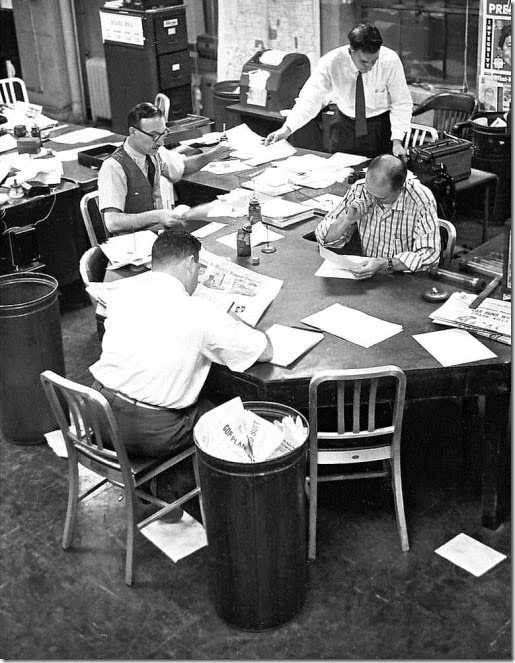 The late Frank Widner was an assistant managing editor at The Indianapolis Times, one of the three great daily newspapers in Indianapolis's modern history.
The late Frank Widner was an assistant managing editor at The Indianapolis Times, one of the three great daily newspapers in Indianapolis's modern history.
He left a personal archive of photos that included shots of his coworkers in the newsroom and in the composing room. They date from the early 1960s, shortly before The Times folded in October, 1965, and just a few years before I started my career at The Indianapolis News in early 1967.
Several refugees from The Times - reporters and printers - were hired by The News and I worked with several of the guys in his photos. Widner was hired by The Indianapolis Star five days after The Times went under and became that paper’s news editor and night assistant managing editor.
The photo I'm posting here includes Carl Henn, who went on to a career in public relations. Always a dapper dresser, Carl is the guy in glasses and a vest. Carl's daughter, Merry Henn, is a Facebook friend and a good Broad Ripple High School friend of my son Sean Flora.
Frank Widner's son Jim Widner has posted much of his dad's archive on his Flickr account: https://www.flickr.com/phot…/mytownindy/…/72157634403304806/
It’s a wonderful look at how we used to do newspapers with typewriters, paste pots, Linotype machines and lots of brilliant, quirky people.
Thursday, January 15, 2015
Sean Flora’s Rock & Roll Bed & Breakfast
 The web site has gone live and it’s IMPRESSIVE!
The web site has gone live and it’s IMPRESSIVE!
If you know anyone who’s looking for a producer and a studio, check out: http://www.rocknrollbnb.com/
Tale a few minutes to explore the site, listen to the music, watch the videos. I’ve watched Sean work with musicians and he can take them to levels they never knew existed.
He is truly an audio genius.
Wednesday, January 14, 2015
Happy Birthday, GT
My 2003 BMW K1200GT was born/built in Berlin on this date 12 years ago.
The photo was shot at 11:03 a.m., Feb. 22, 2003 at Revard BMW Motorcycles in Indianapolis the first time I sat on the bike and wondered if it could be a worth successor to the 1991 K100RS that carried me more than 160,000 miles.
It was.
I took delivery of the GT with 15 miles on the odometer at 10:04 a.m. on March 8, 2003. There were several inches of snow on the ground, but the roads were clear and I don’t remember being particularly cold on the ride home to Thorntown.
Since then, I’ve ridden it to nine BMW MOA rallies:
- 2014 - Minneapolis, MN
- 2012 - Sedalia, MO
- 2010 - Redmond, OR
- 2009 - Johnson City, TN
- 2008 - Gillette, WY
- 2006 - Essex Junction, VT
- 2005 - Lima, OH
- 2004 - Spokane, WA
- 2003 - Charleston, WV
It carried me to Daytona Beach Bike Week in 2010 and 2013, down the Pacific Coast Highway a couple of times, to Las Vegas and Portland to visit my sons, a few times to visit friends in the Colorado Rocky Mountains, and back to Indianapolis three times for MotoGP.
All this riding and more add up to 72,588 miles on the odometer as it sits in my garage this afternoon.
The GT, for those who care about such things, was the K1200RS with color-matched saddlebags and amenities like an electric-powered windscreen, electronic cruise control, and heated seat and handgrips. The model was introduced in 2003 and I had the first one sold by Revard’s.
I added MotoLight caliper-mounted halogen driving lights after a year or so and upgraded them with LED bulbs in 2012. I also added a removable passenger backrest at Maria’s request in 2003, but haven’t used it in years because she’s not keen to ride these days. The Marsee tank bag purchased when I bought the bike finally started falling apart a couple of years ago and I replaced it with a Nelson-Rigg bag with a solar panel in October, 2012.
I also had a Gerbings power cord connected directly to the battery in 2013 after I discovered the accessory circuit didn’t want to run my heated gear and my Garmin Zumo 550 GPS at the same time. That discovery meant I rode to Daytona and back without electric heat, other than seat and grips.
I added a Pirates Lair sidestand footpad in 2003, but it fell/sheared off a few years ago at a Return to Shiloh Rally and I never got around to putting it back on.
Maria bought me an XM Roady satellite radio setup for my birthday in 2004. I used it and later a Roady II until March, 2010 when I bought a used Garmin Zumo 550 GPS with XM radio receiver from BMW friend Charlie Parsons. It was the elegant GPS/XM solution I’d wanted for a long time and satisfied my need to more gadgetry.
So, after a dozen years and a bunch of tweaks, I have the bike set up to suit me. (Oh, I forgot to mention I bought a pair of oversized saddlebags from Revard’s sometime around 2005, which come in handy for long-haul touring.)
I look over the new models whenever I visit a BMW dealership, but other than the high tech safety electronic features like traction control, I don’t see anything that makes me want a new bike.
Tuesday, January 13, 2015
Another thing to worry about
A guy I used to ride with a lot had what I thought a somewhat quirky practice of always paying with cash whenever he refueled his motorcycle.
I think we were on the western edge of Kansas City one afternoon when I finally asked why he didn’t just take advantage of the convenience of paying at the pump with a credit card.
“I don’t like the idea of anyone being able to tell where I am or where I’ve been,” he explained.
That exchange came flooding back to me about 3 a.m. the other day when I awoke with the realization that virtually everything we know, think, do, or say is knowable by an electronic trail that, in the wrong hands, could be used against us.
Think about it.
Our movements away from home are trackable by our cell phones, credit/debit card transactions, even increasingly by security cameras with facial recognition software.
Somewhere there is a charge/debit card record of everything I have bought going back decades.
People unwittingly cooperate with this accumulation of personal information when they make a smart phone – the most intimate portal – their constant companion. It has already been discovered that the art of hacking has reached such a sophisticated level that the microphone and camera on your cell phone and computers can be turned on remotely without you ever knowing it.
And don’t imagine that everything you post or forward on Facebook isn’t recorded somewhere, no matter what your “privacy” settings.
Knowing that our government has built a huge data center in Utah for the collection of whatever information it wants makes this even more disconcerting.
Consider that there is a record somewhere of:
- Every penny you earn and spend.
- Every car you buy or sell.
- Every email and text message and phone conversation you have.
- All of your medical and dental records.
- Everything you have ever looked at on the Internet and all of your searches.
So the question becomes, “Am I paranoid enough?”
Sunday, January 11, 2015
Quiet Sunday
It’s a quiet Sunday here at our house in the woods.
Dora and Jack are snoozing in their favorite porch chairs.
Maria is working on a new quilt and I am thinking about setting up my new Eureka Tetragon 5 tent in the living room.
I determined yesterday that there is room on the living room carpet for its 9’x9’ footprint and it will be a whole lot more comfortable pitching it indoors instead of in the 33° chill outside. (The threatened ice storm failed to materialize this morning. At least not at our house.)
I was going through old photos today and noticed that the big tent Tim and Linda Balough used to take to BMW motorcycle rallies is also a Eureka and looks very much like the Tetragon 5.
Saturday, January 10, 2015
Sixth-grade spelldown hubris
Kate McDowell ran a tiny neighborhood grocery store a couple of blocks from our house in Delphi.
And she had an advertising bar on the screen door like this. (This isn’t Kate’s screen door. Kate died several years ago and her little store was converted into a little church.) That sign led to one of the most humiliating moments of my grade school career.
I was always good at spelling and by the time I reached the sixth grade, I was the consistent winner in classroom spelldowns (or spelling bees, depending on your age and locale). I was good and I knew it and that made me cocky enough that other kids resented it. Nobody likes a champion who lacks humility.
So I smiled inwardly when Mr. Bell, our sixth grade teacher, asked me to spell “wholesome” in the final round.
“This is such a fat pitch. Watch me hit it out of the park,” I thought, visualizing the sign on Kate’s screen door.
“H-O-L-S-U-M,” I replied.
Imagine my horror and embarrassment when I was forced to sit down and the last classmate standing – time has mercifully blocked his or her face and name from my memory – confidently nailed it.
I never looked at Kate’s screen door the same again and I think that was the beginning of a lifetime of mistrust of advertising.
And I will never, ever, buy a loaf of Holsum bread.
Friday, January 09, 2015
Repaired and back on my bike less than 96 hours later
My Garmin Zumo 550 has a new power button and I am absolutely stunned at the quality and swiftness of service by Chris Short at Short Tronics Inc. in Mankato, Minn.
As you may recall from an earlier post here, the power button on my aging Garmin Zumo 550 GPS fell off and vanished last Saturday on a ride to the post office. It’s apparently a fairly common occurrence with older Zumos because time and UV light exposure dry out and degrade rubber. Posts on Zumoforums.com indicate Garmin’s response was to charge owners $150 and swap them for a refurbished unit.
But, I learned, Garmin no longer offers any support for the Zumo 550 other than map upgrades that you may have paid for. Which I had.
Happily, one of the members of the Zumo forum posted a link to Short Tronic’s web site: http://www.palmdr.com/garmin-zumo-450_550-button-repair
I contacted them Sunday afternoon and an hour or so later got a reply from Chris Short, the president of the company, saying they would be happy to repair my GPS for $53.90, which included return shipping and insurance.
I boxed it up and sent it off to Chris via Priority Mail on Monday. I was startled to get an email from him two days later saying he had shipped my repaired GPS back to me that day. He emailed later to say they discovered the Zumo’s internal backup battery that remembers all of the data when the GPS is turned off, needed to be replaced, which they did at an additional cost of $11.95. As far as I’m concerned that’s service above and beyond my expectation that saves me some grief in the future.
My Zumo arrived with its new power button in place this morning less than 96 hours after I shipped it to Chris.
Last Saturday, I thought I was looking at a budget busting new Zumo purchase if I wanted to continue with SiriusXM radio and traffic in a GPS this riding season. Losing the Zumo meant losing the map upgrades I’d paid for as well. I now have my Zumo back and repaired for a fraction of the cost.
St. Anthony to the rescue. Again.
 St. Anthony of Padua is the patron saint of things that are lost.
St. Anthony of Padua is the patron saint of things that are lost.
I have found that an appeal to St. Anthony to help me find some lost or misplaced article pretty much never fails. And so it was with my heavy wool Swedish Army M43 cap that went missing about a month ago.
I found myself drawn to the top shelf of our hall closet where I have a box full of hats. I was certain that my M43 cap wasn’t in the box, but just to be sure, I pulled it down, also checking the space behind the box.
And there it was. Along with a missing cold weather motorcycle glove that I immediately reunited with its mate from the lower shelf.
(The gloves are among the longest-serving motorcycle clothing items in my arsenal of gear. I bought them from a vendor at the Daytona International Speedway during 1993 Bike Week, which makes them about 22 years old. I had ridden to Daytona in a size 3X Carhart coverall over my regular riding apparel and a barely adequate pair of gloves. Besides the new gloves, I also bought a proper cold weather snowmobile-type suit that made the ride back to snowy Indiana much more comfortable.)
But I digress.
There are lots of prayers to St. Anthony for the recovery of lost things. Here is one of the more formal ones:
St. Anthony, perfect imitator of Jesus, who received from God the special power of restoring lost things, grant that I may find (name your lost item)which has been lost. At least restore to me peace and tranquility of mind, the loss of which has afflicted me even more than my material loss. To this favor, I ask another of you: that I may always remain in possession of the true good that is God. Let me rather lose all things than lose God, my supreme good. Let me never suffer the loss of my greatest treasure, eternal life with God. Amen.
A more casual version goes:
Tony, Tony, look around. Something’s lost and must be found.
I usually just say, “St. Anthony, please give me a hand and show me where (insert lost item here) is.”
Typically, when I ask St. Anthony for a little help, less than a minute later the items turn up in a place I was sure they couldn’t be.
I don’t know for sure, but I have a feeling he’ll be happy to help non-Catholics find stuff too.
Thursday, January 08, 2015
Warmth on a cold morning
 I have an air conditioner in the window next to my desk and the weather seal is imperfect, to say the least.
I have an air conditioner in the window next to my desk and the weather seal is imperfect, to say the least.
When it gets cold like it is this morning (13°), it’s downright uncomfortable in our upstairs office. The cold is made even more pronounced by insufficient insulation in the ceiling.
I found a handy solution a few weeks ago when I agreed to test and review this $24.99 desktop ceramic heater offered by the Amazon Vine Program.
Placed on the table between the window and my desk chair, it pumps out a welcome stream of warm air that makes the difference between being able to work at my desk or having to flee to the warmth of downstairs.
I suppose I could store the air conditioner in the attic and close the window, but that would involve moving the table and piles of stuff upon it. But in the meantime, the ceramic heater is a good solution.
Wednesday, January 07, 2015
Hoosier voices
The temperature in Indianapolis this morning is 3°, with wind chills in the -20° range.
I know because I listened to WIBC on my iPhone and Maria’s new Bose Soundlink Bluetooth Color Speaker while I made my morning mocha cappuccino.
I use a $4.99 iPhone app called 00Tunes Radio that lets me hear literally thousands of radio stations worldwide. It accesses virtually every radio station in the world that is on the Internet.
I like hearing WIBC, the Voice of Indiana, because I know most of the places and businesses and people they talk about and I can visualize how miserable a snowy morning commute is there because I have an intimate knowledge of the central Indiana road network.
And sometimes it’s a relief hearing English spoken they way I learned it instead of the Arkansas dialect so prevalent on radio and TV here.
Tuesday, January 06, 2015
Time to stockpile some gasoline
I filled the tank on my Lexus RX330 the other day for $25 and change, prompting me to think about stocking up on gasoline soon.
Gas Buddy tells me regular is going for $1.90 a gallon this morning at Sam’s Club, so my to-do list for today includes filling our three 5 gallon gas cans at Sam’s in anticipation of extended use of our generator or for fueling chain saws, lawn tractor, pressure washer, etc. in the coming months.
I expect gas prices to continue to fall, but the news out of Oklahoma that they jumped back into the $2+ range overnight has me a little twitchy.
LATER: 15.577 gallons of regular for $29.74, treated with fuel stabilizer and stored in the garage.
Monday, January 05, 2015
Sledding at Butler Hill
I see it snowed in Indianapolis over the weekend and more is expected, so this is a good time to revisit the good times my family and I had sledding at the hill on the Butler University campus, less than a mile from our house.
We accessed the hill through a hole in the chain link fence off of Boulevard Place, along the east side of the campus.
It was one of the best sledding hills I’ve seen, although the one near the water tower at Thorntown is pretty good too.
We had my Flexible Flyer from the 1950s and also a nifty steerable yellow plastic sled that was insanely fast. The Flexible Flyer is in my garage and the yellow speeder resides in Thorntown with Maria’s parents, for the use of various and sundry grandchildren.
The runout area was compromised in later years with the construction of a dance academy at the foot of the hill.
Sunday, January 04, 2015
Another reason why I love the Internet
The more I looked into fixing my Garmin Zumo 550 yesterday afternoon, the more depressed I got.
As I mentioned yesterday, Garmin no longer offers repair support for this model. I found enough posts in various places about this problem to make it clear that it’s pretty common and there is no shortage of creative jerry-rigged button replacements.
I was ready to cut a small piece of black nitrile glove material and superglue it over the hole before Maria mentioned she has some thicker rubber material in her sewing supplies that might be better.
But before I committed to that approach, I found a link in a Zumoforums.com post to a company that repairs buttons on the Zumo 400, 450, and 550.
Here’s the link, in case anyone else with this problem stumbles onto this blogpost: http://www.palmdr.com/garmin-zumo-450_550-button-repair
I just used their online contact form to let them know I’m keen to have them fix my GPS. If this works, I will sing their praises loudly and forever.
LATER:
I just got an email from palmdr.com saying they can repair my power button for $46.90 plus $7 return shipping. They said the repair will be done within 5 days of receipt of the unit, usually less.
Maybe it’s a good thing that Garmin doesn’t work on them anymore.
I'll let you know how it works out.
Saturday, January 03, 2015
Fusion Media loses another customer
Looks like the Rainwaters, who live close enough to us that I could shoot these pictures from my front yard, are fed up with Fusion Media cable service after nearly three weeks of on-and-off service.
They’re having DirectTV installed today.
I have to admit that I’m having a hard time staying positive about Fusion Media’s recovery efforts, especially when they promised us a week’s credit as compensation, yet the bill that arrived Friday was for the full amount.
I thought I would give my spirits a lift this afternoon by taking my first motorcycle ride of the new year, even if it was just to the post office.
The weather radar shows the rain has moved on, but failed to prepare me for the heavy mist that had windshield wipers flapping back and forth on the cars I met on the highway.
 And my mood turned seriously black when I got home and found the rubber cover for the on/off switch of my GPS was gone. This means the unit can still be turned off and on, but is no longer weatherproof.
And my mood turned seriously black when I got home and found the rubber cover for the on/off switch of my GPS was gone. This means the unit can still be turned off and on, but is no longer weatherproof.
I did some online research, including checking with the Garmin.com site and discovered that Garmin no longer supports the Zumo 550.
It seems this vanishing button cover issue is not an uncommon problem for Zumo users. Back when Garmin still supported the unit, they were able to send their Zumo to the company and get a refurbished 550 back. But those days are over and it looks like I may be fucked.
I really hadn’t planned to buy a new GPS for the 2015 riding season, but barring some miracle, I may be forced to replace the 550 rather than repair it.
Oh, and today’s mail brought two contradictory notices about Maria’s Obamacare health insurance. One confirms her coverage and the other suggests it has lapsed. It’s a good thing this is Saturday and the Arkansas Blue Cross Blue Shield offices are closed, because I really don’t have the patience to try to sort this out with someone with a sub-room temperature I.Q. who will almost certainly question whether I am authorized to speak in behalf of my wife, even though they have documents on file granting me that authority.
Friday, January 02, 2015
Can’t find my favorite winter hat
I’ve had this heavy wool Swedish Army cap for more than 15 years, but sometime within the last month it went missing.
I hate losing things, especially useful things I’ve become attached to. Chances are that it will turn up, but now that winter is here, I don’t feel like waiting.
It’s a copy of a WWII German M43 cap which, in turn, owes its design to a Tyrolean ski cap. The cap features fold-down ear flaps for the most severe cold.
I got it on Ebay back in the late 1990s and the only thing wrong with it was that the stiffening material in the bill was fractured and made for an uneven look, although you can’t see it in this photo shot after a Christmas Day snowstorm in 2012.
Ebay is full of replica German M43 caps, but most of them are made in China, which I have come to regard as being of dubious quality. I did find some being sold out of New Jersey (for all I know, they were made in China too) for about $30, so I pulled the trigger this afternoon and bought one.
Thursday, January 01, 2015
New year, new tent
Since I’m going to turn 70 this year *shudder* I decided to treat myself to a tent I can stand up in.
The Eureka Special Galyan’s Edition Timberline two-man tent I’ve used at motorcycle rallies since the 2005 BMW MOA in Lima, Ohio is showing its age. I noticed water wicking into the bottom of the tent at the BMW MOA rally last summer in St. Paul, Minn., and again when it rained at the Falling Leaf Rally in October in Potosi, Mo.
It’s been a great tent that packs down to the smallest package of any tent I’ve owned and kept me safe and dry through many a torrential rain, but the ceiling 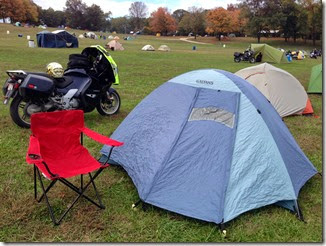 is low – I still have to crouch when I’m on my knees – and I didn’t relish climbing the learning curve of re-sealing the floor seams, a fix that might or might not work.
is low – I still have to crouch when I’m on my knees – and I didn’t relish climbing the learning curve of re-sealing the floor seams, a fix that might or might not work.
I started perusing the Eureka web site a month or two ago, shopping for something that would give me more headroom and space to spread out a bit more than the two-man Timberline afforded.
I finally settled on the 5-person Tetragon 5. It has a 6-foot ceiling and a 9x9-foot floor (81 square feet of floor space, for the math impaired). That seems kind of extravagant, but I figure after nearly 70 years on planet Earth and 40 years of occasional tent camping, I deserve it.
So with the generous help of my son Steve and my wife Maria, I pulled the trigger on a Tetragon 5 yesterday on Amazon.com.
Now I have to revisit my packing strategy to accommodate a 28-inch-long tent package on the luggage rack of my K1200GT.


